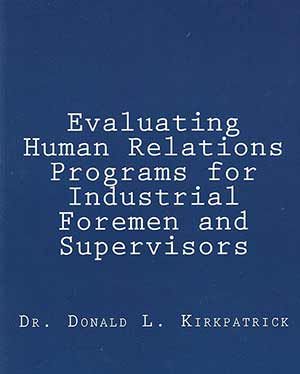Evaluating Human Relations Programs for Industrial Foremen and Supervisors
$19.95
Bulk pricing available for 10+ copies: contact us for a quote
Evaluating Human Relations Programs for Industrial Foremen and Supervisors is an unedited reprinting of Dr. Donald L. Kirkpatrick’s doctoral dissertation exactly as it was written in 1954.
Within it lies the beginning of what is known today as the four levels of training evaluation.
The Kirkpatrick Model is 50 Years New
Evaluating Human Relations Programs for Industrial Foremen and Supervisors is an unedited reprinting of Dr. Donald L. Kirkpatrick’s doctoral dissertation exactly as it was written in 1954. Within it lies the beginning of what is known today as the Kirkpatrick model of training evaluation.
“I never called it a ‘model’ and I never referred to the four words as levels,” said Don Kirkpatrick. “I was just trying to determine if my programs for managers and supervisors were successful in helping them to perform better on the job.”
Take advantage of this rare opportunity to read the origins of what has become one of the most utilized and respected training evaluation models in the world. See for yourself where the world has gained the insight to evaluate training programs on four important dimensions.
For those of you working on your own doctoral dissertation or planning to in the future, may this serve as an inspirational guide for you. Hopefully your work will also positively impact the world of workplace learning and performance.
Bulk pricing available for 10+ copies: contact us for a quote
Evaluating Human Relations Programs for Industrial Foremen and Supervisors is an unedited reprinting of Dr. Donald L. Kirkpatrick’s doctoral dissertation exactly as it was written in 1954.
Within it lies the beginning of what is known today as the four levels of training evaluation.
The Kirkpatrick Model is 50 Years New
Evaluating Human Relations Programs for Industrial Foremen and Supervisors is an unedited reprinting of Dr. Donald L. Kirkpatrick’s doctoral dissertation exactly as it was written in 1954. Within it lies the beginning of what is known today as the Kirkpatrick model of training evaluation.
“I never called it a ‘model’ and I never referred to the four words as levels,” said Don Kirkpatrick. “I was just trying to determine if my programs for managers and supervisors were successful in helping them to perform better on the job.”
Take advantage of this rare opportunity to read the origins of what has become one of the most utilized and respected training evaluation models in the world. See for yourself where the world has gained the insight to evaluate training programs on four important dimensions.
For those of you working on your own doctoral dissertation or planning to in the future, may this serve as an inspirational guide for you. Hopefully your work will also positively impact the world of workplace learning and performance.








Reviews
There are no reviews yet.